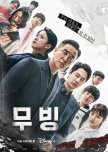Good slice of life superhero series
The acting and VFX in the Korean drama series are both excellent, but the editing is so lazy and uninspired that it ruins the entire experience. The series is a snooze fest for the most part, with long stretches of exposition that are interrupted by sudden bursts of violence. The editing is also riddled with continuity errors that break the immersion of the series.
For example, in one scene, a character may be shown crying, but in the next scene, they are suddenly smiling. Or, a character may be shown walking down the street, but in the next scene, they are suddenly standing in a different location. These continuity errors are jarring and can take viewers out of the story.
The series' editing problems are also evident in its pacing. The series is incredibly slow for the most part, with long stretches of nothing happening. The filmmakers seem to be afraid to cut anything, even though there are many scenes that could have been removed or shortened without harming the story.
For example, there may be a long scene in which the main characters are talking, but they are mostly just repeating themselves or saying nothing of importance. Or, there may be a long scene of a character walking from one place to another. These scenes could have easily been cut or shortened without losing any important information.
The series' climax is also often overlong. The action sequences may be well-choreographed, but they go on for too long and become repetitive. The filmmakers could have easily cut the action sequences by a few minutes without losing any of the excitement.
Overall, the series' editing is simply terrible. It's clear that the filmmakers didn't put much thought or effort into it. As a result, the series is a chore to watch, and it's impossible to get invested in the story.
If the filmmakers had taken the time to edit their series more carefully, it could have been a much better series. The acting and VFX are both excellent, and the stories have potential. However, the lazy and uninspired editing ruins the entire experience.
In addition to the above, here are some specific examples of editing problems that are common in Korean drama series:
* **Excessive use of slow-motion:** Korean drama series often overuse slow-motion, especially in romantic scenes. This can make the series feel slow-paced and draggy.
* **Unnecessary close-ups:** Korean drama series also often use unnecessary close-ups, especially of the actors' faces. This can be distracting and take viewers out of the story.
* **Poor scene transitions:** Korean drama series sometimes have poor scene transitions, which can make the series feel disjointed and confusing.
* **Inconsistent tone:** Korean drama series sometimes have an inconsistent tone, shifting between comedy, drama, and romance abruptly. This can make the series feel jarring and disorienting.
Despite these editing problems, Korean drama series remain popular with viewers around the world. This is likely due to the fact that they often have well-developed characters, engaging storylines, and high production values. However, it is a shame that the editing of these series often lets them down.
For example, in one scene, a character may be shown crying, but in the next scene, they are suddenly smiling. Or, a character may be shown walking down the street, but in the next scene, they are suddenly standing in a different location. These continuity errors are jarring and can take viewers out of the story.
The series' editing problems are also evident in its pacing. The series is incredibly slow for the most part, with long stretches of nothing happening. The filmmakers seem to be afraid to cut anything, even though there are many scenes that could have been removed or shortened without harming the story.
For example, there may be a long scene in which the main characters are talking, but they are mostly just repeating themselves or saying nothing of importance. Or, there may be a long scene of a character walking from one place to another. These scenes could have easily been cut or shortened without losing any important information.
The series' climax is also often overlong. The action sequences may be well-choreographed, but they go on for too long and become repetitive. The filmmakers could have easily cut the action sequences by a few minutes without losing any of the excitement.
Overall, the series' editing is simply terrible. It's clear that the filmmakers didn't put much thought or effort into it. As a result, the series is a chore to watch, and it's impossible to get invested in the story.
If the filmmakers had taken the time to edit their series more carefully, it could have been a much better series. The acting and VFX are both excellent, and the stories have potential. However, the lazy and uninspired editing ruins the entire experience.
In addition to the above, here are some specific examples of editing problems that are common in Korean drama series:
* **Excessive use of slow-motion:** Korean drama series often overuse slow-motion, especially in romantic scenes. This can make the series feel slow-paced and draggy.
* **Unnecessary close-ups:** Korean drama series also often use unnecessary close-ups, especially of the actors' faces. This can be distracting and take viewers out of the story.
* **Poor scene transitions:** Korean drama series sometimes have poor scene transitions, which can make the series feel disjointed and confusing.
* **Inconsistent tone:** Korean drama series sometimes have an inconsistent tone, shifting between comedy, drama, and romance abruptly. This can make the series feel jarring and disorienting.
Despite these editing problems, Korean drama series remain popular with viewers around the world. This is likely due to the fact that they often have well-developed characters, engaging storylines, and high production values. However, it is a shame that the editing of these series often lets them down.
Esta resenha foi útil para você?




